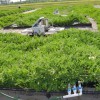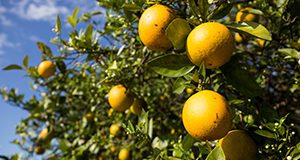Microirrigation is an important component of citrus production systems in Florida. For citrus trees, microirrigation is more desirable than other irrigation methods for several reasons: water conservation, fertilizer management efficiency, and freeze protection. Research has shown that when microirrigation systems are properly managed, water savings can amount to as much as 80% compared with subirrigation and 50% compared with overhead sprinkler irrigation. Research has also shown the important advantage of microsprinklers for freeze protection of citrus. This 4-page fact sheet discusses fertilizer solubility and some common fertigation materials. It also offers a fertigation summary. Written by Mongi Zekri, Arnold Schumann, Tripti Vashisth, Davie Kadyampakeni, Kelly Morgan, Brian Boman, and Tom Obreza, and published by the UF Horticultural Sciences Department, September 2017.
http://edis.ifas.ufl.edu/hs1306
Tag: Brian Boman
Flatwoods Citrus Best Management Practice: Riser-Board Structures
 Water discharge structures are used to control water table levels and surface water levels in drainage and irrigation ditches within flatwoods citrus groves. The type of structure selected can significantly influence the quality of water discharged. With flashboard risers, water is forced to flow over the top board. This flow path creates a low current area toward the bottom, which facilitates the deposition of sediments and their accompanying nutrients or pesticides, essentially removing them from the discharges. Conversely, screw-gate structures do not create this dead-current zone. Since they open from the bottom, sediments are swept out along with the discharge water. Written by Chris Wilson, Liberta Scotto, Brian Boman, and Tim Gaver. Original publication date February 2002. Revised April 2012 and August 2015.
Water discharge structures are used to control water table levels and surface water levels in drainage and irrigation ditches within flatwoods citrus groves. The type of structure selected can significantly influence the quality of water discharged. With flashboard risers, water is forced to flow over the top board. This flow path creates a low current area toward the bottom, which facilitates the deposition of sediments and their accompanying nutrients or pesticides, essentially removing them from the discharges. Conversely, screw-gate structures do not create this dead-current zone. Since they open from the bottom, sediments are swept out along with the discharge water. Written by Chris Wilson, Liberta Scotto, Brian Boman, and Tim Gaver. Original publication date February 2002. Revised April 2012 and August 2015.
https://edis.ifas.ufl.edu/ss409
Flatwoods Citrus Best Management Practice: Soil Stabilization

This best management practice describes stabilization practices for erosion-prone soils within flatwoods citrus groves. Significant amounts of soil may be deposited in drainage ditches and canals because of the erosion of grove soils. These deposited soils reduce the capacity for holding and transporting water. Plus, very small soil fractions may be suspended in discharge water then settle out in slower flowing areas and destroy submerged aquatic habitats, resulting in the loss of fish, invertebrate, and plant species important for healthy ecosystems. Fortunately, a variety of slope stabilization methods are available. This publication describes considerations for using plants for stabilization, or mulch-like materials. Written by P. Chris Wilson, Liberta Scotto, Brian Boman, and Tim Gaver. Original publication date March 2002. Revised April 2012 and August 2014. Reviewed August 2015.
http://edis.ifas.ufl.edu/ss408
Water Use for Drip-Irrigated Watermelon with Plastic Mulch in Florida
 Watermelon is an important crop in Florida and accounts for a significant part of its agricultural water use. Watermelon is grown in open fields and on raised plastic-mulched beds, with the latter being the predominant production system in Florida. Accurate water use estimates for this crop are needed to develop better water allocation and management plans as well as for irrigation management. This publication summarizes the results from a crop water-use study for the drip-irrigated watermelon in south Florida. This 3-page fact sheet was written by Sanjay Shukla, Niroj K. Shrestha, Thomas A. Obreza, and Brian J. Boman, and published by the UF Department of Agricultural and Biological Engineering, August 2014.
Watermelon is an important crop in Florida and accounts for a significant part of its agricultural water use. Watermelon is grown in open fields and on raised plastic-mulched beds, with the latter being the predominant production system in Florida. Accurate water use estimates for this crop are needed to develop better water allocation and management plans as well as for irrigation management. This publication summarizes the results from a crop water-use study for the drip-irrigated watermelon in south Florida. This 3-page fact sheet was written by Sanjay Shukla, Niroj K. Shrestha, Thomas A. Obreza, and Brian J. Boman, and published by the UF Department of Agricultural and Biological Engineering, August 2014.
http://edis.ifas.ufl.edu/ae508
A Guide to EPA’s Numeric Nutrient Water Quality Criteria for Florida (SL316/SS528)
This revised 10-page guide provides a basic, concise, and understandable description of the United States Environmental Protection Agency’s (EPA) numeric nutrient criteria for Florida, the background events that led to its release, some pertinent scientific issues, and implications for the future. Written by Thomas Obreza, Mark Clark, Brian Boman, Tatiana Borisova, Matt Cohen, Michael Dukes, Tom Frazer, Ed Hanlon, Karl Havens, Chris Martinez, Kati Migliaccio, Sanjay Shukla, and Alan Wright, and published by the UF Department of Soil and Water Science, March 2011.
http://edis.ifas.ufl.edu/ss528
AE248 Fertilizer Application Best Management Practices for Citrus Grove Workers
Revised! AE248, a 12-page fact sheet by Brian Boman, Darren Cole, Steve Futch, Ward Gunter, Jack Hebb, and Chris Wilson, instructs citrus grove workers in fertilizer application best management practices. Includes references and quizzes throughout. Published by the UF Department of Agricultural and Biological Engineering, March 2009.
http://edis.ifas.ufl.edu/ae248
SL316/SS528 A Guide to EPA’s Proposed Numeric Nutrient Water Quality Criteria for Florida
SL316, a 9-page illustrated guide by Thomas Obreza, Mark Clark, Brian Boman, Tatiana Borisova, Matt Cohen, Michael Dukes, Tom Frazer, Ed Hanlon, Karl Havens, Chris Martinez, Kati Migliaccio, Sanjay Shukla, and Alan Wright, provides a basic, concise, and understandable description of the United States Environmental Protection Agency’s (EPA) proposed numeric nutrient criteria for Florida, the background events that led to its release, some pertinent scientific issues, and implications for the future. Published by the UF Department of Soil and Water Science, February 2010.
http://edis.ifas.ufl.edu/ss528
CIR1039/AE080 Treating Irrigation Systems with Chlorine
Revised! Circular 1039, a 7-page illustrated fact sheet by Kati W. Migliaccio, Brian Boman and Gary A. Clark, provides a guide for using chlorine to treat inhibiting microorganism buildup in irrigation systems. Includes references. Published by the UF Department of Agricultural and Biological Engineering, May 2009.
http://edis.ifas.ufl.edu/AE080
AE244 Pesticide Safety and Personal Protective Equipment for Citrus Grove Workers
AE244, an 11-page fact sheet by Brian Boman, Darren Cole, Steve Futch, Ward Gunter, Jack Hebb, Chris Wilson, is part of the Best Management Practices (BMPs) for Citrus Grove Workers series. It provides information for citrus grove workers about toxicity and effects of exposure to pesticides and personal protective equipment. Includes two quizzes and references. Published by the UF Department of Agricultural and Biological Engineering, February 2009.
http://edis.ifas.ufl.edu/AE244
AE247 Pesticide Application Best Management Practices for the Citrus Grove Worker
AE247, an 15-page fact sheet by Brian Boman, Darren Cole, Steve Futch, Ward Gunter, Jack Hebb, Chris Wilson, is part of the Best Management Practices (BMPs) for Citrus Grove Workers series. It provides information for citrus grove workers about pests, pest control methods, pesticide toxicity,how to transport pesticides, first aid and decontamination, preventing exposure, worker protection standard, storage and disposal, pre-operation checkpoints, mixing and loading, container management, calibration, application best management practices . Includes three quizzes and references. Published by the UF Department of Agricultural and Biological Engineering, April 2009.
http://edis.ifas.ufl.edu/AE247
AE246 Herbicide Application Best Management Practices for Citrus Grove Workers
Revised! AE246, a 13-page illustrated fact sheet by Brian Boman, Darren Cole, Steve Futch, Ward Gunter, Jack Hebb, Chris Wilson, is part of the Best Management Practices (BMPs) for Citrus Grove Workers series. It covers personal protective equipment, tractor and herbicider preventive maintenance, mixing and loading, posting, important stepts to take before application, herbicide application, equipment clean up, and spill containment. Includes three comprehension quizzes and references. Published by the UF Department of Agricultural and Biological Engineering, March 2009.
http://edis.ifas.ufl.edu/AE246
ABE367/AE243 Understanding the Pesticide Label for Citrus Grove Workers
Revised! ABE-367, a 5-page fact sheet by Brian Boman, Darren Cole, Steve Futch, Ward Gunter, Jack Hebb, Chris Wilson, is part of the Best Management Practices (BMPs) for Citrus Grove Workers series. It emphasizes the importance of reading pesticide labels, the risks of misusing pesticides, and what is on the label. Includes a 10 question quiz and references. Published by the UF Department of Agricultural and Biological Engineering, March 2009.
http://edis.ifas.ufl.edu/AE243
AE439 Best Management Practices (BMPs): Perimeter Borders
AE439, a 2-page illustrated fact sheet by Kati W. Migliaccio, Brian Boman, Jemy Hinton, and Kevin Hancock, describes perimeter borders used in agricultural production systems in Florida, their benefits and maintentance. Includes references. Published by the UF Department of Agricultural and Biological Engineering, January 2009.
http://edis.ifas.ufl.edu/AE439
ABE383/AE432 BMP: Ribbon Barriers
ABE-383, a 2-page illustrated fact sheet by Kati W. Migliaccio, Brian Boman, Jemy Hinton, and Kevin Hancock, addresses a specific set of Best Management Practices that can be described as ribbon barriers. Includes references. Published by the UF Department of Agricultural and Biological Engineering, October 2008.
http://edis.ifas.ufl.edu/AE432
